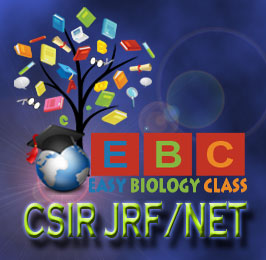1. Penicillin-resistant bacteria produce β-lactamase which inactivates penicillin by:
a. Esterifying the carboxyl group
b. Oxidizing S atom
c. Hydrolyzing the side chain
d. Hydrolyzing the C-N bond
Ans. (d)
β-lactamases or penicillinase are a class of enzymes produced by some bacteria which degrade penicillin antibiotic and thereby impart resistance against penicillin. All penicillin antibiotics contain a β-lactum ring structure which is essential for the antibiotic activity. The β-lactamase enzyme will degrade the β-lactum ring and thus inhibit the antibiotic properties.
2. Pseudo-murein is present in cell wall of:
a. Streptococci
b. Staphylococci
c. Methanococci
d. Micrococci
Ans. (c). Methanococci
Methanococci is an Archaebacteria.
Pseudo-murein or pseudo-peptidoglycan is a major cell wall component of some Archaebacteria. It is structurally different from the peptidoglycan of the true bacteria. However, it is functionally similar to the peptidoglycan wall of bacteria. Pseudo-murein is a hetero-polysaccharide of N-acetylglucosamine and N-acetyltalosaminuronic acid connected by β-1,3-glycosidic bonds. Lysozyme enzyme is unable to degrade the pseudo-murein cell wall.
Learn more: Difference between Murein and Pseudo-murein
Learn more: Comparison table of Bacteria, Archaea and Eukarya
3. Bacteria that can penetrate intact corneal epithelium is:
a. Pseudomonas aeruginosa
b. Staphylococus aureus
c. Listeria monocytogenes
d. Yersinia pestis
Ans. (b). Staphylococus aureus
4. Which of the following bacterial toxins does not have ADP-ribosyl transferase activity:
a. Cholera toxin
b. Diphtheria toxin
c. Exotoxin A
d. S aureus α toxin
Ans. (d). S. aureus α toxin
Cholera toxin, Diphtheria toxin and Exotoxin A possess ADP ribosyl transferase activity.
S. aureus α toxin is produced by Staphylococcus aureus do not have the ADP-ribozyl transferase and they induce apoptosis.
5. In what part of the plant are auxins produced?
a. Mesophylls cells
b. Vascular bundles
c. Shoot meristems
d. Root meristem
Ans. (d)
Learn more: Meristem in Plants: Characteristics & Classification
6. The oxygen carrying protein of invertebrates is:
a. Hemoglobin
b. Hemocyanin
c. Myoglobin
d. Ceruloplasmin
Ans. (b). Hemocyanin
Hemocyanin is a copper containing protein in some insects which can carry oxygen. Unlike the hemoglobin, the hemocyanin protein can carry only one O2 molecule at a time.
Hemoglobin and myoglobin are the oxygen carrying proteins of vertebrates.
Ceruloplasmin is a copper carrying protein in human.
7. The bond length of hydrogen bond in water is approximately:
a. 0.177 nm
b. 0.177 Å
c. 1.77nm
d. 0.77µm
Ans. (a). 0.177 nm
Learn more: How Hydrogen Bond is Formed in Water?
Learn more: Physical, Chemical and Unusual Properties of Water
Learn more: Biological Significance of Water
Learn more: Why the pH of water is 7? (Video Tutorial)
8. In cells that have not been previously exposed to lactose, how does lactose enter the cell to induce lac operon
a. IPTG would induce the expression instead of lactose
b. Lactose would enter by diffusion across the membrane without the need for permease
c. Some other transport protein facilitates the entry of lactose
d. Basal level of expression of lac operon, leading to the low level synthesis of permeases
Ans. (d)
9. Which is the most preferred carbon source for E coli
a. Glucose
b. Glycerol
c. Galactose
d. Sucrose
Ans. (a)
10. Interferons:
a. Activate B cells to make virus specific antibodies
b. Are Th2 cytokines
c. Are virus proteins that interfere with activation of cytotoxic t cells
d. Inhibit virus replication by infected cells
Ans. (d)
Interforons or IFNs are proteins belong to a large class called cytokines. Cytokines are used to communicate between cells to trigger defense reactions to eradicate the invading pathogens.
Learn more: Interferons: Properties, Functions and Classification
Lear more: Difference between Type I and Type II Interferons
11. Activated form of insulin contains:
a. Two inter chain disulphide bonds
b. Two intra-chain and one inter chain disulphide bonds
c. One intra chain and two inter chain disulphide bonds
d. Two intra-chain disulphide bonds
Ans. (c)
12. Which of the following is not considered as a prion disease?
a. Kuru
b. CJD
c. BSE
d. Alzheimer
Ans. (d)
13. It was found that normal stem cells isolated from brain have a doubling time of 24 hours; whereas tumor derived cells have a doubling time of 12 hours. Both these cells types were grown in the presence of radioactive thymidine for 24 hours, following which they were grown in normal media. After the end of a week, radioactivity per cell will be:
a. Double in stem cells as compared to cancer cells
b. Half in stem cells as compared to cancer cells
c. Same in both stem and cancer cells
d. None in stem cells and high levels in cancer cells
Ans. (b)
14. Which of the following genotype frequencies of AA Aa and aa respectively satisfy the Hardy-Weinberg principle?
a. 0.29, 0.42, 0.29
b. 0.36, 0.55, 0.09
c. 0.49, 0.42, 0.09
d. 0.64, 0.27, 0.09
Ans. (a)
Learn more: Hardy Weinberg Equilibrium Principle
15. How many different genotypes are possible in the ova of a woman who is heterozygous at four different loci?
a. 8
b. 16
c. 64
d. 2
Ans. (b) 16
It is calculated with the formula 2^n, where n is the number of heterozygous loci. Here in the question, there are 4 heterozygous loci. 2^4 = 2 X 2 X 2 X 2 = 16
CSIR JRF NET Life Sciences June (I) 2017 Exam Model Questions
| Set 1/4 | Set 2/4 | Set 3/4 | Set 4/4 |
| You may also like NOTES in... | ||
|---|---|---|
| BOTANY | BIOCHEMISTRY | MOL. BIOLOGY |
| ZOOLOGY | MICROBIOLOGY | BIOSTATISTICS |
| ECOLOGY | IMMUNOLOGY | BIOTECHNOLOGY |
| GENETICS | EMBRYOLOGY | PHYSIOLOGY |
| EVOLUTION | BIOPHYSICS | BIOINFORMATICS |

I want to qualify net examination.